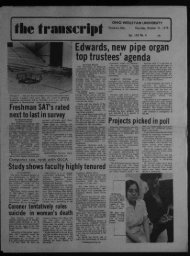

Using recycled pipes and keyboards and new all-electric windchests which he built and wired, he made a small practice organ for his office at the church, a larger one for his home in Brooklyn, and later a still larger one for the church auditorium. Under his leadership, several projects for expansion of the organ at Flatbush-Tompkins Church came to fruition. Ramsey also had a keen amateur interest in organ building, both theoretical and practical. His estate intends to donate the relatively few surviving pieces to the Curtis Institute archives. Excessive modesty prevented him from publishing any of them, and he later destroyed most of the manuscripts. In addition to being an organist and choir director, Ramsey composed many choral and organ pieces for use in his various churches. He then became organist at First Universalist Church of Southold, where he served for seven years until 2004, when eye problems prevented him from driving. He remained there 22 years, resigning in January 1997. Soon after, he was invited to become organist and choirmaster at First Presbyterian Church in Southold, New York. In 1975 he and Margaret retired to their summer home in New Suffolk, New York. He married Margaret Irvine, the Tompkins Avenue church secretary retained in the merger.

He was also organist at Temple Ahavath Sholom in Flatbush. He directed a choir of more than 30 singers with paid section leaders. In 1942, Tompkins Avenue Congregational Church merged with Flatbush Church, and Ramsey was retained as music director of the Flatbush-Tompkins Congregational Church that, with over 4,000 members, became the largest Congregational church in the country.

While serving this church, he continued his organ studies with David McKay Williams at St. Kimball Organ Company representative to audition for the minister of music position at Flatbush Congregational Church in Brooklyn, New York, where Kimball had recently rebuilt its 1912 organ. Mary’s Episcopal Church, Hamilton Village, Philadelphia, which had recently installed a new Aeolian-Skinner organ (1937). While at Curtis he was appointed organist at St. He received a scholarship to the Curtis Institute of Music, Philadelphia, Pennsylvania, where he studied organ with Alexander McCurdy. Mark’s Methodist Church, Atlanta, which he served for seven years. Two years later, at age 17, he became organist at St. Born in 1914 in Atlanta, Georgia, he studied organ with Joseph Ragan at All Saints Episcopal Church, Atlanta, where he served as assistant organist and junior choir director. Vaughan Ramsey, 102, died August 3, 2016, in New Suffolk, New York. Memorial gifts may be made to the Huber Music Scholarship Fund, Kansas Wesleyan University, Salina. A funeral service was held January 23 at University United Methodist Church, Salina. Harry Huber is survived by his wife of 71 years, Sara Huber nieces Sara Gault of Salina, Carole Gray and husband Milton of The Villages, Florida, and Jeanne Watson-Smith and husband Kirby of Kennett Square, Pennsylvania great-niece Mollie Purcell and husband Ben great-great nephews Gage Roberts and Carter Purcell. A 33rd degree Mason, he was organist of the local Scottish Rite organization. At the age of 96, he retired as organist of University United Methodist Church of Salina, after 58 years of service. Two years later he accepted a position teaching music at Kansas Wesleyan University, Salina, retiring in 1979 after 32 years of service. In 1945, Huber moved to Hutchinson, Kansas, to become director of music for First United Methodist Church. His organ studies took him to Philadelphia, New York, Boston, and Köln, Germany. He studied at Temple University and Boston University, earning degrees in piano, music theory, and organ. He was born January 17, 1914, in Gibbstown, New Jersey. Harry Huber, 102, of Salina, Kansas, died January 13.


 0 kommentar(er)
0 kommentar(er)
